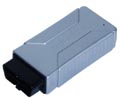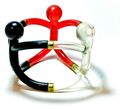- Basic Information
- |
- Repair Basics
- |
- Technical Info
- |
- Car Tech Info
- |
- MicroTronik
Vehcile Electronics

1- The conventional theory, commonly used for automotive systems, says current flows from (+) to (-) ... excess electrons flow from an area of high potential to one of low potential (-).
2 -The electron theory, commonly used for electronics, says current flows from (-) to (+) ... excess electrons cause an area of negative potential (-) and flow toward an area lacking electrons, an area of positive potential (+), to balance the charges.
While the direction of current flow makes a difference in the operation of some devices, such as diodes, the direction makes no difference to the three measurable units of electricity: voltage, current, and resistance.
AutoHex (Auto Diagnostic scanner) is one of the best Professional scan tools to for Cars; Autohex Scanner can test the Systems of the Car effectively and easily, with many powerful features to help you in diagnosing and testing.
Electronics Basic Information
- Terms of Electricity
Explain the three important terms in electricity , voltage , Current and Resistance
- The Law of Ohm
Define the Law of Ohm in Electricity and Electrical power and work,The Law of Ohm says: The current in a circuit is directly proportional to the applied voltage and inversely proportional to the amount of resistance. , SOURCE VOLTAGE, CURRENT, RESISTANCE, ELECTRIC POWER AND WORK
- Factors Affecting Resistance
Defining the five factors affecting the resistance of conductors, which are length of the conductor, diameter, temperature, physical condition and conductor material and these factors apply to circuit wiring as well as working devices or loads.
- Actions of Current
The effects of the Current flow has different types, like generating heat or electromagnetism or chemical reactions ,Actions of Current Current flow has the following effects; motion, light or heat generation, chemical reaction, and electromagnetism.
- Types of Electricity
There are two types of electricity and it is static or dynamic electricity we explain about in this section.There are two types of electricity: static and dynamic. Dynamic electricity can be either direct current (DC) or alternating current (AC).
- Electrical Circuits
The basic definition of electrical circuits of the Vehicle ,A power source (battery or alternator) produces voltage, or electrical potential. Conductors (wires, printed circuit boards) provide a path for current flow. Working devices, or loads (lamps, motors), change the electrical energy into another form of energy to perform work.
- Power Sources on the Car
Two power sources are used on vehicles. When the engine is not running or is being started, the battery provides power. When the engine is running, the alternator provides power for the loads of the vehicle and for recharging the battery.
- Types of resistors
Three basic types of resistors are use in automotive electrical systems, fixed value resistors, stepped or tapped resistors, and variable resistors. Different symbols are used for the different types of resistors.
- Type of Capacitors
Capacitors use an electrostatic field to store an electrical charge. In a circuit, a capacitor will build up a charge on its negative plate. Current flows until the capacitor charge is the same as that of the power source. It will hold this charge until it is discharged through another circuit (such as ground).
- Electronic Control Switches
Control devices used in electrical circuits on vehicles include a variety of switches, relays, and solenoids. Electronic control devices include capacitors, diodes, and transistors. Controls are needed to start, stop, or redirect current flow. Most switches require physical movement for operation, relays and solenoids are operated with electromagnetism,
- Electronic Devices
Electronic devices and systems provide vehicles with added comfort, convenience, safety, and performance. These devices and systems control electricity to do work. The current flows through a semiconductor - rather than through wires.
- Protective Devices
Electrical circuits are protected from too much current by fuses, fusible links, and circuit breakers. Such devices will interrupt a circuit to prevent high current from melting conductors and damaging loads. Each of these circuit protection devices is sensitive to current, not voltage, and is rated by current-carrying capacity.
Key learning when all keys lost


